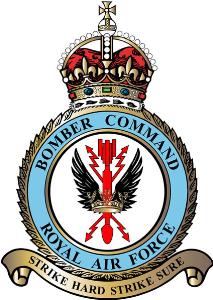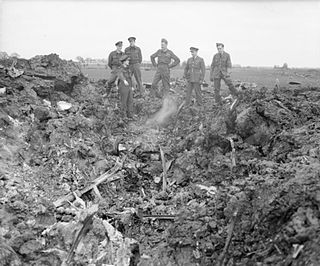
A light bomber is a relatively small and fast type of military bomber aircraft that was primarily employed before the 1950s. Such aircraft would typically not carry more than one ton of ordnance.

A night fighter is a fighter aircraft adapted for use at night or in other times of bad visibility. Night fighters began to be used in World War I and included types that were specifically modified to operate at night.

An attack aircraft, strike aircraft, or attack bomber is a tactical military aircraft that has a primary role of carrying out airstrikes with greater precision than bombers, and is prepared to encounter strong low-level air defenses while pressing the attack. This class of aircraft is designed mostly for close air support and naval air-to-surface missions, overlapping the tactical bomber mission. Designs dedicated to non-naval roles are often known as ground-attack aircraft.

RAF Bomber Command controlled the Royal Air Force's bomber forces from 1936 to 1968. Along with the United States Army Air Forces, it played the central role in the strategic bombing of Germany in World War II. From 1942 onward, the British bombing campaign against Germany became less restrictive and increasingly targeted industrial sites and the civilian manpower base essential for German war production. In total 364,514 operational sorties were flown, 1,030,500 tons of bombs were dropped and 8,325 aircraft lost in action. Bomber Command crews also suffered a high casualty rate: 55,573 were killed out of a total of 125,000 aircrew, a 44.4% death rate. A further 8,403 men were wounded in action, and 9,838 became prisoners of war.

The Douglas A-20 Havoc is an American medium bomber, attack aircraft, night intruder, night fighter, and reconnaissance aircraft of World War II.
Serrate was a World War II Allied radar detection and homing device used by night fighters to track Luftwaffe night fighters equipped with the earlier UHF-band BC and C-1 versions of the Lichtenstein radar. It allowed RAF night fighters to attack their German counterparts, disrupting their attempts to attack the RAF's bomber force.

The German city of Cologne was bombed in 262 separate air raids by the Allies during World War II, all by the Royal Air Force (RAF). A total of 34,711 long tons of bombs were dropped on the city by the RAF. 20,000 people died during the war in Cologne due to aerial bombardments.
Wing Commander Bransome Arthur "Branse" Burbridge, was a Royal Air Force (RAF) night fighter pilot and flying ace—a pilot credited with at least five enemy aircraft destroyed—who holds the Allied record of 21 aerial victories achieved at night during the Second World War.

The Helmore/GEC Turbinlite was a 2,700 million candela (2.7 Gcd) searchlight fitted in the nose of a number of British Douglas Havoc night fighters during the early part of the Second World War and around the time of The Blitz. The Havoc was guided to enemy aircraft by ground radar and its own radar. The searchlight would then be used to illuminate attacking enemy bombers for defending fighters accompanying the Havoc to shoot down. In practice the Turbinlite was not a success and the introduction of higher performance night fighters with their own radar meant they were withdrawn from service in early 1943.

Operation Steinbock, sometimes called the Baby Blitz, was a strategic bombing campaign by the German Air Force during the Second World War. It targeted southern England and lasted from January to May 1944. Steinbock was the last strategic air offensive by the German bomber arm during the conflict.

The Defence of the Reich is the name given to the strategic defensive aerial campaign fought by the Luftwaffe air arm of the combined Wehrmacht of Nazi Germany over German-occupied Europe and Nazi Germany during World War II. Its aim was to prevent the destruction of German civilians, military and civil industries by the Western Allies. The day and night air battles over Germany during the war involved thousands of aircraft, units and aerial engagements to counter the Allied strategic bombing campaign. The campaign was one of the longest in the history of aerial warfare and with the Battle of the Atlantic and the Allied Blockade of Germany was the longest of the war. The Luftwaffe fighter force defended the airspace of German-occupied territory against attack, first by RAF Bomber Command and then against the United States Army Air Forces (USAAF) in the Combined Bomber Offensive.
Nachtjagdgeschwader 1 (NJG 1) was a German Luftwaffe night fighter-wing of World War II. NJG 1 was formed on 22 June 1940 and comprised four Gruppen (groups). NJG 1 was created as an air defence unit for the Defence of the Reich campaign; an aerial war waged by the Luftwaffe against the bombing of the German Reich by RAF Bomber Command and the United States Air Force. In 1941 airborne radar was introduced with radar operators, and standardised in 1942 and 1943. Consequently, a large number of German night fighter aces existed within NJG 1.
Nachtjagdgeschwader 2 was a German Luftwaffe night fighter and night intruder wing during World War II.

The de Havilland Mosquito was a British light bomber that served in many roles during and after the Second World War. Mosquito-equipped squadrons performed medium bomber, reconnaissance, tactical strike, anti-submarine warfare and shipping attack and night fighter duties, both defensive and offensive. Mosquitos were widely used by the RAF Pathfinder Force, which marked targets for night-time strategic bombing. Despite an initially high loss rate due to low-level daylight attack operations, the Mosquito ended the war with the lowest losses of any of the aircraft types in RAF Bomber Command service.

Air warfare was a major component in all theaters of World War II, and, together with anti-aircraft warfare, consumed a large fraction of the industrial output of the major powers. Germany and Japan depended on air forces that were closely integrated with land and naval forces; the Axis powers downplayed the advantage of fleets of strategic bombers, and were late in appreciating the need to defend against Allied strategic bombing. By contrast, Britain and the United States took an approach that greatly emphasised strategic bombing, and tactical control of the battlefield by air, as well as adequate air defences. Both Britain and the U.S. built substantially larger strategic forces of large, long-range bombers. Simultaneously, they built tactical air forces that could win air superiority over the battlefields, thereby giving vital assistance to ground troops. The U.S. and Royal Navy also built a powerful naval-air component based on aircraft carriers, as did the Japanese; these played the central role in the war at sea.

No. 255 Squadron RAF was a Royal Air Force Squadron formed as an anti-submarine unit in First World War and a night-fighter unit in Second World War. The First World War squadron was formed from former Royal Naval Air Service coastal flights and was responsible for coastal anti-submarine patrols. It was disbanded after the war.

A night bomber is a bomber aircraft intended specifically for carrying out bombing missions at night. The term is now mostly of historical significance. Night bombing began in World War I and was widespread during World War II. A number of modern aircraft types are designed primarily for nighttime bombing, but air forces no longer refer to them as night bombers. More common terms today include interdictor and strike fighter, and such aircraft tend to have all-weather, day-or-night capabilities.

Operation Gisela was the codename for a German military operation of the Second World War. Gisela was designed as an aerial intruder operation to support the German air defence system in its night battles with RAF Bomber Command during the Defence of the Reich campaign. It was the last major operation launched by the Luftwaffe Nachtjagdgeschwader during the conflict.

The aircrews of RAF Bomber Command during World War II operated a fleet of bomber aircraft carried strategic bombing operations from September 1939 to May 1945, on behalf of the Allied powers. The crews were men from the United Kingdom, other Commonwealth countries, and occupied Europe, especially Poland, France, Czechoslovakia and Norway, as well as other foreign volunteers. While the majority of Bomber Command personnel were members of the RAF, many belonged to other air forces – especially the Royal Canadian Air Force (RCAF), Royal Australian Air Force (RAAF) and Royal New Zealand Air Force (RNZAF). Under Article XV of the 1939 Air Training Agreement, squadrons belonging officially to the RCAF, RAAF, and RNZAF were formed, equipped and financed by the RAF, for service in Europe. While it was intended that RCAF, RAAF, and RNZAF personnel would serve only with their respective "Article XV squadrons", in practice many were posted to units of the RAF or other air forces. Likewise many RAF personnel served in Article XV squadrons.














